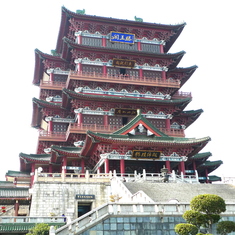
Famous Buildings of Ancient China
Last updated: Thursday August 25th, 2022
Report this blog
When people speak of China, one would bring to mind such landmarks as the Great Wall, the Forbidden City and the Terracotta Warriors. However, these places only show an aspect of Chinese history, that of politics and imperial rule, and they cannot give tourists an insight into Chinese culture. The spirit and cultural heritage of the Chinese people can be seen in the vast numbers of poems and pieces of literature dedicated by scholars and imperial subjects, most notably towards mountains, rivers, and of course, buildings. The famous buildings of ancient China are renowned by the Chinese people, not because of their amazing architecture, but because of the spirit and merits given to them by the pieces of literature dedicated for them.
The Pavilion of Prince Teng, Yellow Crane Tower and Yueyang Tower are three of the most famous buildings of ancient China. All three buildings have passages and poems dedicated to them. Over time, these buildings have gradually become the symbol of Chinese cultural heritage, as well as an indication of ancient Chinese merits. Here are the stories concerning these three (as well as other) famous buildings of ancient China, as well as an extension on other types of Chinese architecture.
Pavilion of Prince Teng
The Pavilion of Prince Teng (滕王阁, téng wáng gé) is situated on the right bank of the Gan River in the city center of Nanchang, Jiangxi Province. It was first built in the year 653, and it is 57.5 meters tall. Upon its completion, the pavilion has become the landmark of Nanchang and a symbol of Chinese culture.
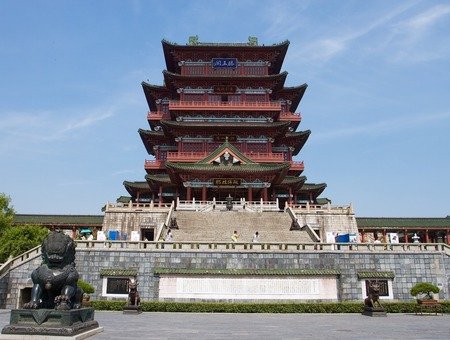
The Pavilion of Prince Teng was named after Li Yuanying (628 ~ 684), a younger brother of Emperor Taizong of Tang Dynasty. Li Yuanying was made governor of Tengzhou (in modern-day Shandong, Tengzhou means "land of Teng") at a young age, and since Chinese noblemen were often known for the land they governed, Li Yuanying became known as Prince Teng. A wealthy patron, Prince Teng financed the building of many buildings as he travelled on post throughout China, most notable of which were the three pavilions he built, all named in his honor as the Pavilion of Prince Teng, located in Tengzhou, Nanchang and Langzhong respectively. The Pavilion of Prince Teng in Nanchang is the only one that survived the ages, being destroyed and rebuilt numerous times.
When Prince Teng arrived in Nanchang, he chose a site besides the Gan River to construct his second masterpiece. After its completion, luxurious banquets and parties were held, even after the prince had left for his post in Langzhong. More than twenty years after its completion, a twenty-five-year-old youth approached this building, during his visit to his father. The name of this youth is Wang Bo (650 ~ 676), a gifted person who had been an official on the imperial court. In office as tutor of the crown prince, Wang Bo wrote a passage about cricket fighting, infuriating the emperor into thinking that he misguided the prince with too much entertainment. As a result, Wang Bo was dismissed from court, and his father was demoted to be an official in a faraway place in modern-day Vietnam.
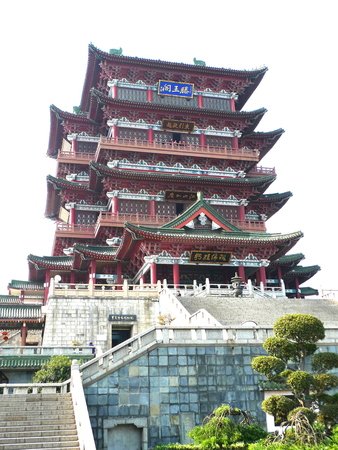
Though he was young, Wang Bo was an ambitious man who sought to do much on the imperial court, and this event disheartened him. As a result, as he was passing Nanchang on his way to visit his father, Wang felt ashamed, but he was still hopeful of re-establishing his position. Thus, when he saw the newly-built pavilion, he decided to join the banquet held by a general under Prince Teng. During the banquet, the general called upon his guests to make up poems and passages for the occassion. A nephew of Prince Teng volunteered, and he wrote a splendid passage, praising the scenery from the pavilion. Of course, this passage was pre-composed by several people serving under Prince Teng, and the nephew merely dictated it from memory. However, the nephew clearly wanted this opportunity to show his talents and impress his audience.
Wang Bo was displeased at the nephew's performance. He stood up and offered to write a passage for the occasion. The elder people at the banquet laughed, for they did not believe that a youth can surpass their work. Presently Wang Bo sat down, and with the ink brush in his hand, began to write, "Nanchang, which was the capital of Yuzhang Prefecture during the Han Dynasty, now falls under the jurisdiction of Hongzhou. It straddles the border between the Ye and Zhen constellations, and is adjacent to the Heng and the Lu mountains. The three rivers enfold it like the front part of a garment and the five lakes encircle it like a girdle. It controls the Man and the Jing peoples and connects the Ou with the Yue...."
Thus was born Tengwang Ge Xu, or "Preface to a Farewell Feast Atop the Pavilion of Prince Teng". The host and the guests marveled at Wang Bo's genius as he described the autumn scenery, and they were touched by Wang's optimism and his ambitions on the imperial court. When Wang Bo wrote "The brilliance of the sunset shoots through the rosy clouds along with the silhouette of a lonely heron, and the autumn water is merged with the boundless sky into one hue...", the general himself stood up and applauded with all the guests. Since that moment, Tengwang Ge Xu had become a classic of Chinese literature, and Wang Bo's genius became recognized by all the guests. Sadly, however, on his way back from his visit to his father, Wang Bo drowned in a river, aged only twenty-six, and a literary genius was lost. As he did not leave behind many written works, Tengwang Ge Xu is regarded as the peak of his creation.
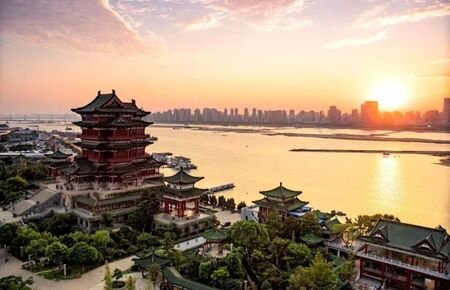
As the Pavilion of Prince Teng became the inspiration for Wang Bo's work, so did Wang Bo's work immortalize the pavilion. When years of war in the ensuing dynasties destroyed much of China's cultural heritage, the Pavilion of Prince Teng was rebuilt again and again, and many famous literary people visited this building to pay their respects to Wang Bo. When his reformation failed, former prime minister Wang Anshi (1021 ~ 1086) ascended the pavilion and wrote about his lost ambitions. A literary giant of the Northern Song Dynasty, Su Shi (1037 ~ 1101) visited the pavilion and transcribed Wang Bo's work, accompanied by his friend, Huang Tingjian (1045 ~ 1105), a well-known calligrapher. War generals and poets of the Southern Song Dynasty, Xin Qiji (1140 ~ 1207) and Wen Tianxiang (1236 ~ 1283) arrived at the pavilion to pay their respects to their ancestors before attempting to regain their ancestor's lands through war. Famous philosopher Wang Yangming (1472 ~ 1529) came to the pavilion to pay tribute to former Chinese scholars. Tang Xianzu (1550 ~ 1616), a prominent playwright of the Ming Dynasty, chose to premiere his play, "The Peony Pavilion", in the plaza before the Pavilion of Prince Teng, another masterpiece of Chinese literature.
The modern history of China was turbulent and full of struggles. During the wars in which millions were killed, much of China was left in ruin. As a result, famous architect Liang Sicheng (1901 ~ 1972) sought to redesign the Pavilion of Prince Teng, regaining its past splendor. The construction was delayed for many years, and the new pavilion was completed in 1989, according to Liang's design. Now, the Pavilion of Prince Teng proudly stands in Nanchang, visited by tourists all around China. It has become the symbol of Chinese literary culture.
Yellow Crane Tower
Yellow Crane Tower (黄鹤楼, huáng hè lóu) is situated on a small hill near the eastern bank of the Yangtze River in Wuchang district of Wuhan, Hubei Province. It was first built in the year 223, and it is 51.4 meters tall. Upon its completion, the tower has become the landmark of Wuhan and a symbol of Chinese culture.

During the three kingdoms period, warlord Sun Quan (182 ~ 252) called for the construction of an observation tower near the Yangtze River. Yellow Crane Tower was completed in the year 223, and with it came a small city that would become known as Wuchang, now a major district of Wuhan. In a folk tale, there was a daoshi (priest of Taoism) who drank at a local pub every day without paying, but the barkeeper was never angry with him. To repay the barkeeper, the daoshi drew the picture of a yellow crane on the wall of the pub. He explained that every day, the crane would come down from the wall and dance to entertain the customers. Sure enough, the yellow crane earned much popularity, and people from all around flock to see the crane, making the pub full of customers and the barkeeper quite gratified. When the daoshi came back ten years later, he took out a flute which he played, and presently the yellow crane jumped down from the wall, spread its wings, and bore the daoshi away. For this reason, the new observation tower was named Yellow Crane Tower.
When he ascended Yellow Crane Tower, poet Cui Hao (704 ~ 754) of the Tang Dynasty wrote a poem regarding the folk tales of the tower, the scenery on the tower, and his feelings of nostalgia. The poem is translated as follows:
The sage on yellow crane was gone amid clouds white.
To what avail is Yellow Crane Tower left here?
Once gone, the yellow crane will never on earth alight;
Only white clouds still float in vain from year to year.
By sunlit river trees can be counted one by one;
On Parrot Islet sweet green grass grows fast and thick.
Where is my native land beyond the setting sun?
The mist-veiled waves of the Yangtze makes me homesick.
Like many other poets of his era, Cui Hao wanted to spread his influence and do more for the emperor on the imperial court, but he was always dejected, never fulfilling his ambition, going from post to post faraway from his homeland. Thus, this poem is unsurpassed by all other poems written for buildings, and it was this poem that brought Yellow Crane Tower into the spotlight of Chinese culture. When they visited the building, well-known poets Li Bai (701 ~ 762, known as "genius of poets") and Du Fu (718 ~ 770, known as "saint of poets") all marveled at this poem and see it as unsurpassed.
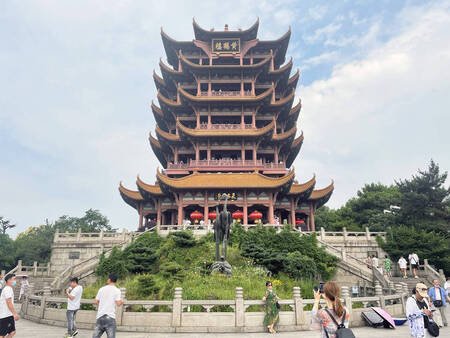
Over the years, many famous poets and scholars visited this building. Partly because of its legends of ancient sages flying away on a yellow crane, Yellow Crane Tower became known as "First Building Under the Heavens". After it was rebuilt in 1985, Yellow Crane Tower stands in Wuhan to this day, the landmark of Wuhan and a symbol of Chinese culture.
Yueyang Tower
Yueyang Tower (岳阳楼, yuè yáng lóu) is situated on an ancient city wall on the eastern bank of Dongting Lake in Yueyang, Hunan Province. It was first built in the year 215, and it is 19.42 meters tall. Although it is not as magnificent as the two preceding buildings, Yueyang Tower has become the landmark of Yueyang and a symbol of Chinese culture. This is because of a passage, dedicated to this tower, whose author had never been there.
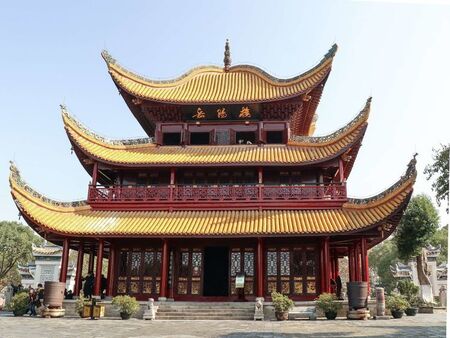
Yueyang Tower was first built by Lu Su (172 ~ 217), a military strategist under Sun Quan, as a military stronghold. Over the next couple of centuries, it gradually became an attraction to view the scenery of Dongting Lake. In 1045, Teng Zijing (991 ~ 1047), governor of Yuezhou (modern-day Yueyang, Yuezhou means "land of Yue") renovated Yueyang Tower. To record his feats, Teng Zijing sent a letter, together with a painting of Dongting Lake and Yueyang Tower, to his friend, Fan Zhongyan (989 ~ 1052), a famous politician and writer. Fan Zhongyan observed the painting closely, and he linked it with his emotions towards his country to create Yueyang Lou Ji, or “Notes on Yueyang Tower".
In this passage, Fan Zhongyan first narrated how Teng Zijing renovated the tower, then he went on to describe the views of Yueyang Tower, based on his feelings. Last of all, Fan told of his worries for his country and his people as well as his belief "to worry before all the people under the heavens and to enjoy after all the people under the heavens". Here is a translation of the last paragraph of Yueyang Lou Ji, in which Fan Zhongyan expressed his emotions towards his country:
Alas! I have sought the philosophy of ancient sages, which are perhaps different from the two moods I described above, but why? They did not express joy or sorrow at external objects or personal gains and losses. When they were in a high position on the imperial court, they would worry about the people; when they were on a small post far away from the capital, they would worry about the emperor. This would mean that they worry when they get promoted, and they also worry when they get demoted. In this case, when would they be happy? Then we must say, "To worry before all the people under the heavens and to enjoy after all the people under the heavens." Alas! If there were no such persons, whom should I accompany?
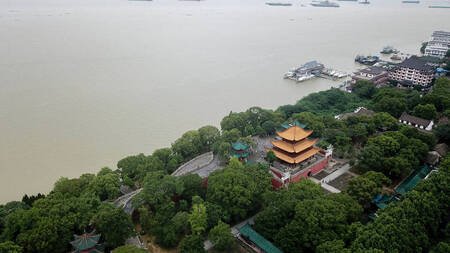
Ironically, though Fan Zhongyan had never been to Yueyang Tower, it was his work that immortalize the tower. Since its reconstruction in 1934, thousands of tourists from all over China ascends this building annually, to pay tribute to Fan's spirit of "to worry before all the people under the heavens and to enjoy after all the people under the heavens", which had since become a representative of Chinese patriotism. Yueyang Tower now stands in Yueyang, a local landmark and a symbol of Chinese literary culture.
Other Famous Buildings of Ancient China
The Pavilion of Prince Teng, Yellow Crane Tower and Yueyang Tower are collectively known as "Three Famous Buildings of Jiangnan", in which Jiangnan means "south of the Yangtze River". Besides these three, other buildings are also known for their history and literary culture. Here are a brief account of the other famous buildings of ancient China.
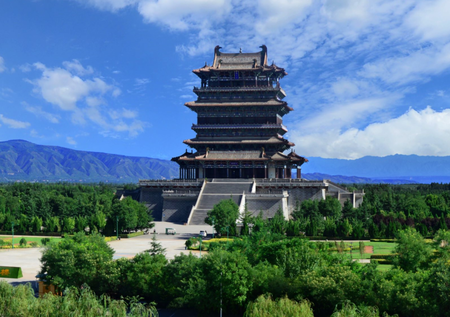
Guanque Tower (鹳雀楼, guàn què lóu, guanque means "stork") is located near Yuncheng, Shanxi Province, on the right bank of the Yellow River, and it is 73.9 meters tall. It was first constructed in the sixth century, and it was burnt down in 1222, reopening in 2002. The appearance of the building is a form of color painting from the Tang Dynasty, the formula of which was lost in history. Guanque Tower was made famous by Wang Zhihuan (688 ~ 742) 's poem, "Ascending Guanque Tower":
The sun beyond the mountain glows,
The Yellow River seaward flows.
You can enjoy a grander sight,
By climbing to a greater height.
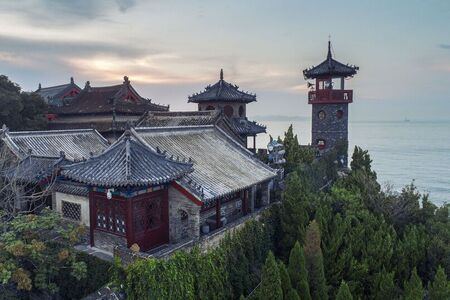
Penglai Pavilion (蓬莱阁, péng lái gé) is a building complex located near Yantai, Shandong Province, on the edge of the sea, and it is 32,800 square meters in size. In Chinese mythology, Penglai is a paradise on Earth to the east of the sea. In the Chinese myth "Eight Immortals Crossing the Sea", eight immortal men used their power to cross the sea to arrive in Penglai. Penglai Pavilion was built in 1061, never being destroyed or renovated in nearly a thousand years. It serves as a symbol of the paradise that normal people cannot reach, but where every person wants to go.
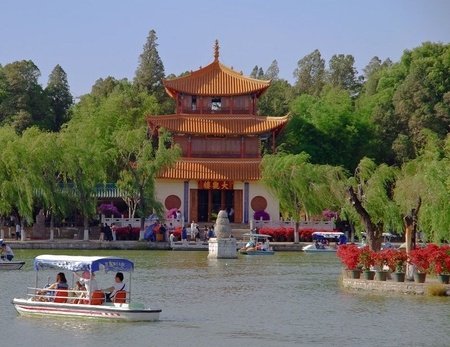
Grand View Tower (大观楼, dà guān lóu) is located in Kunming, Yunnan Province, by the tip of Dian Lake, and it is 18 meters tall. It was first built in 1690 by Wang Jiwen, the governor of Yunan at that time. Wang discovered that standing on the tower, he could see the blue rippling waves and the dotted fishing vessels, making his heart relax, so he gave it its name. Grand View Tower is a typical example of traditional Yunnan architecture, with triple eaves and a pointed roof, decorated with local painting styles and woodcarving. The tower was reconstructed in 1883.
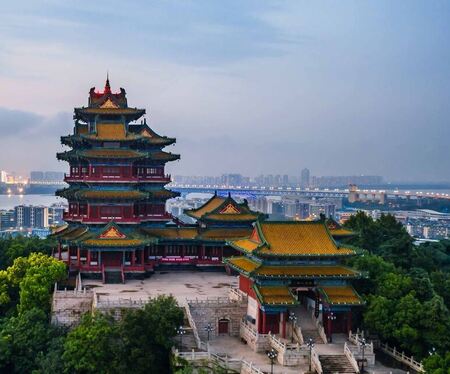
Yuejiang Tower (阅江楼, yuè jiāng lóu, yuejiang means "viewing the Yangtze river") is located on a hill in Nanjing, Jiangsu Province, overlooking the Yangtze River, and it is 52 meters tall. It was commissioned to be built in 1374 by Zhu Yuanzhang (1328 ~ 1398), first emperor of the Ming Dynasty, after Nanjing became capital. Zhu Yuanzhang asked all his officials to each submit a passage with the title "Ascending Yuejiang Tower", while workers began to lay the groundwork for the building. However, Yuejiang Tower was never finished, because Zhu Yuanzhang claimed that in his dream, God told him not to continue building. Yuejiang Tower finally opened in 2001.
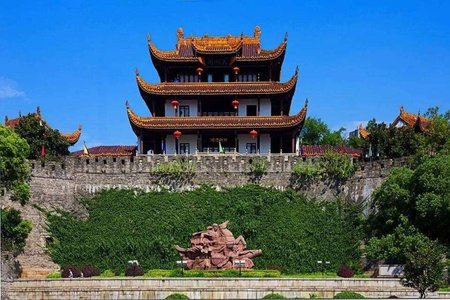
Tianxin Pavilion (天心阁, tiān xīn gé) is located on the ancient city wall of Changsha, Hunan Province, and it is 17.5 meters tall. The name Tianxin comes from the Book of Documents (Shang Shu) and means "heart of heaven". It was first constructed in 1746, the highest point in the city, so it serves as a fort to defend the city during wartimes. The city wall under the pavilion is more than two thousand years old, constructed during the Han Dynasty. Tianxin Pavilion was destroyed and reconstructed thirteen times, and the current building was erected in 1984.
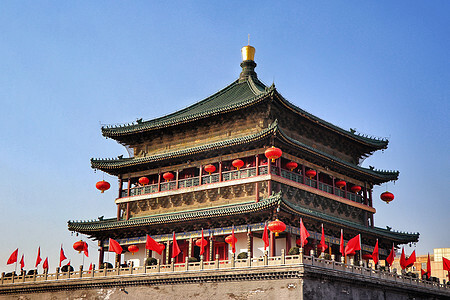
Bell Tower (钟楼, zhōng lóu) and Drum Tower (鼓楼, gǔ lóu) are the important components of a major city in ancient China. Constructed in 1384, Bell Tower in Xi'an is located in the middle of a crossroad on a square pedestal, opposite Drum Tower, which is on the side of the street. Bell Tower is 36 meters tall, and there used to be a huge bell suspended on the building, used to tell the time or declare emergencies.
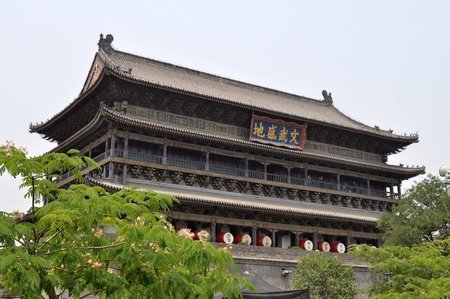
Constructed in 1380, Drum Tower in Xi'an was built on a square pedestal, and it is 34 meters tall. On one side of the building is a roll of huge drums, which used to be hit by drummers to signify the start of a new hour, much like what a clock tower does. Along with Bell Tower, Drum Tower is a symbolic landmark of Xi'an, reminding people of the city's history.
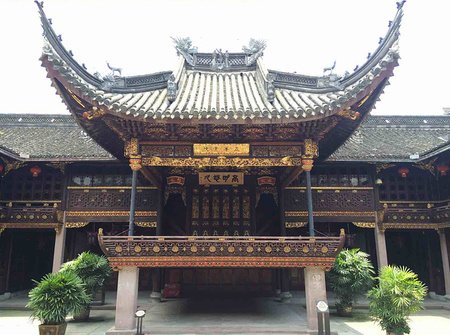
Tianyi Pavilion (天一阁, tiān yī gé) is located in the city center of Ningbo, Zhejiang Province, and it is 26,000 square meters in size. Built in 1561 by a retired official named Fan Qin, it is one of the world's oldest private libraries. The name Tianyi comes from the Book of Changes (Yi Jing) and means "heaven" or "sky". As the library is constructed of wood and the books are made of paper, Fan Qin was worried about fire, so he consulted the Book of Changes, which said, "Heaven gives birth to water (tian yi sheng shui)." Fan believed that since water extinguishes fire, naming the library tianyi would help prevent fire, and sure enough, Tianyi Pavilion never fell to the flames.
Other Types of Chinese Architecture
There are many types of buildings in Chinese architecture, the most basic of which include ting, tai, lou and ge. Ting is a small building with an opened interior and a curved roof, usually located on the side of the road for traveller to rest, similar to a booth, but usually translated as a pavilion. Tai, also written as tan, is often located on a pedestal, with a wide, opened place on the top for people to relax or view the scenery, similar to a platform or a terrace. Lou is a tall and the most common form of a building, with multiple floors, translated as a tower. Ge varies in appearance, but is usually a large building seemingly floating in the sky, or a building for storing books, also translated as a pavilion. So far, the famous buildings in ancient China only covers lou and ge. The section gives an introduction on the types of building known in Chinese as ting and tai.
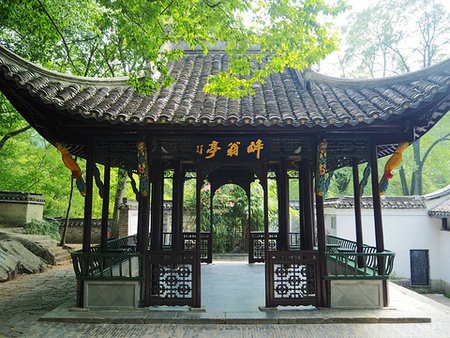
Zuiweng Pavilion (醉翁亭, zuì wēng tíng) is located on the hills in Chuzhou, Anhui Province. It was built in 1047 by Ouyang Xiu (1007 ~ 1072), famous politician and writer of the Song Dynasty. Ouyang Xiu was fond of wine, so while feasting with his friends, he often get drunk, and since he is the eldest among his friends, he gave himself the nickname Zuiweng (zui means "drunk", and weng means "elderly man"). On his post in Chuzhou, Ouyang Xiu took to the hills around the city, so one of his friends built a pavilion for him on the hills, which Ouyang named after himself. In his work Zuiweng Ting Ji, or "Notes on Zuiweng Pavilion", Ouyang Xiu wrote, "The Old Drunkard [referring to himself] delights less in drinking wine than in the hills and streams, taking pleasure in them and expressing the feeling in his heart through drinking."
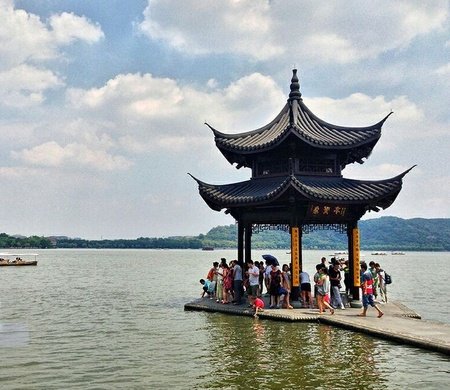
Huxin Pavilion (湖心亭, hú xīn tíng, huxin means "heart of the lake") is located in the center of West Lake, Hangzhou, Zhejiang Province. It was built during the Ming Dynasty, visited by tourists because of the panoramic view that the pavilion offers. Zhang Dai (1597 ~ 1689), literary critic and writer of the late Ming and early Qing Dynasty, wrote in his work Huxin Ting Kan Xue ("Watching Snow in Huxin Pavilion") , "Frost fills the entire surface of the lake. The sky, the cloud, the mountain, and the water are all white as salt from above to the bottom. All that can be seen in the lake is the dike, the pavilion, the dinghy and several people. And due to the mist, the dike looks like a line, the pavilion a dot, the dinghy a reed, and the people resembles the moving chess pieces."
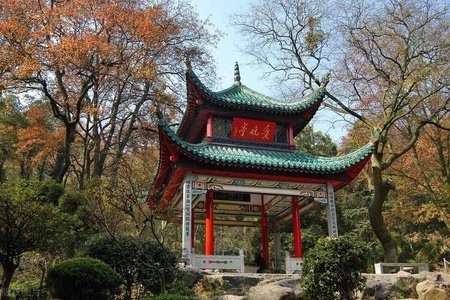
Aiwan Pavilion (爱晚亭, aì wǎn tíng) is located at the foot of Yuelu Mountain in Changsha, Hunan Province. It was built in 1795, and it is 6.23 meters tall. Aiwan Pavilion is famous for its view in autumn, with the red maple leaves reaching to the roof of the pavilion. Aiwan comes out of the poem "Going Up the Hill" written by poet Du Mu (803 ~ 852). Here is a translation of this poem:
A slanting stony path leads far to the cold hill;
Where fleecy clouds are born, there appear cots and bowers.
I stop my cab in maple woods to gaze my fill;
Frost-bitten leaves look redder than early spring flowers.

Heptachord Terrace (古琴台, gǔ qín tái) is located at the foot of a hill by a small pond in Hanyang District of Wuhan, Hubei Province. It was first built during the Song Dynasty to honor the friendship between Yu Boya and Zhong Ziqi. Boya was a famous heptachord musician of the state of Chu during the Spring and Autumn Period of Ancient China. Zhong Ziqi was a woodcutter who could understand Boya's emotions through his music. As a result, Boya played the heptachord to Zhong Ziqi every day, and they became the best of friends, a relationship known as zhiyin ("understand music") in Chinese. When Zhong Ziqi died, Boya was devastated, so he destroyed his heptachord and became a hermit, believing that nobody else could understand him anymore.
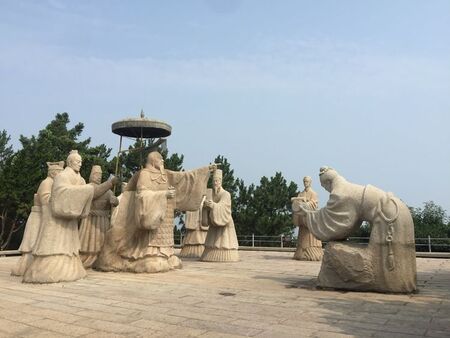
Langya Terrace (琅琊台, láng yá tái) is located near Qingdao in Shandong Province. With an altitude of 183.4 meters, it lies between the hills and the sea, notable for its scenery. It was first built in 471 BC by Gou Jian (? ~ 464 BC), king of the state of Yue, after he moved the capital of Yue to Langya (in the south of modern-day Qingdao). After he reunited China, Qin Shi Huang (259 BC ~ 210 BC) arrived here to reconstruct the terrace, recording his merits and contributions on stele. He also asked one of his advisors to sail from here to seek for immortals east of the sea, seeking for the Elixir of Life. Unfortunately, Qin Shi Huang eventually died from eating such medicine.
The famous buildings of Chinese architecture are symbols of Chinese history and culture. Although they may have been re-erected countless times, they still stand proudly in their ancient sites, welcoming thousands of tourists each year. The Chinese people extend their warmest greetings to tourists wishing to learn about the history and culture of ancient China.
